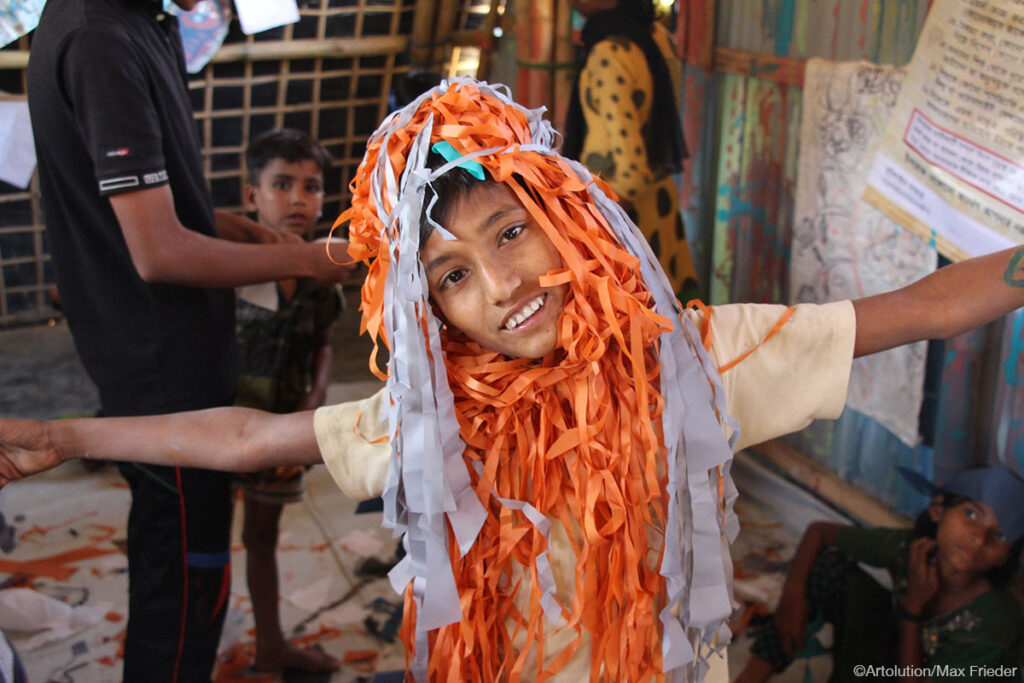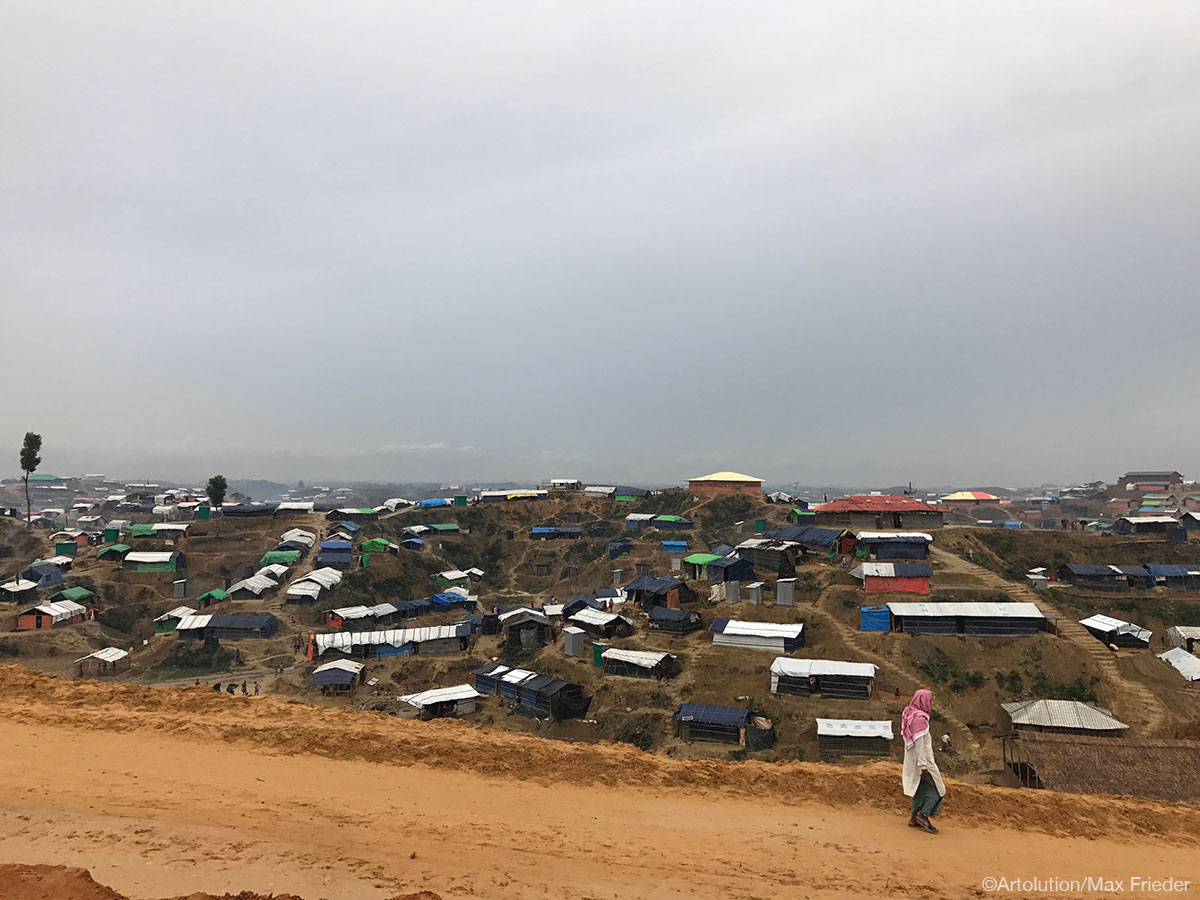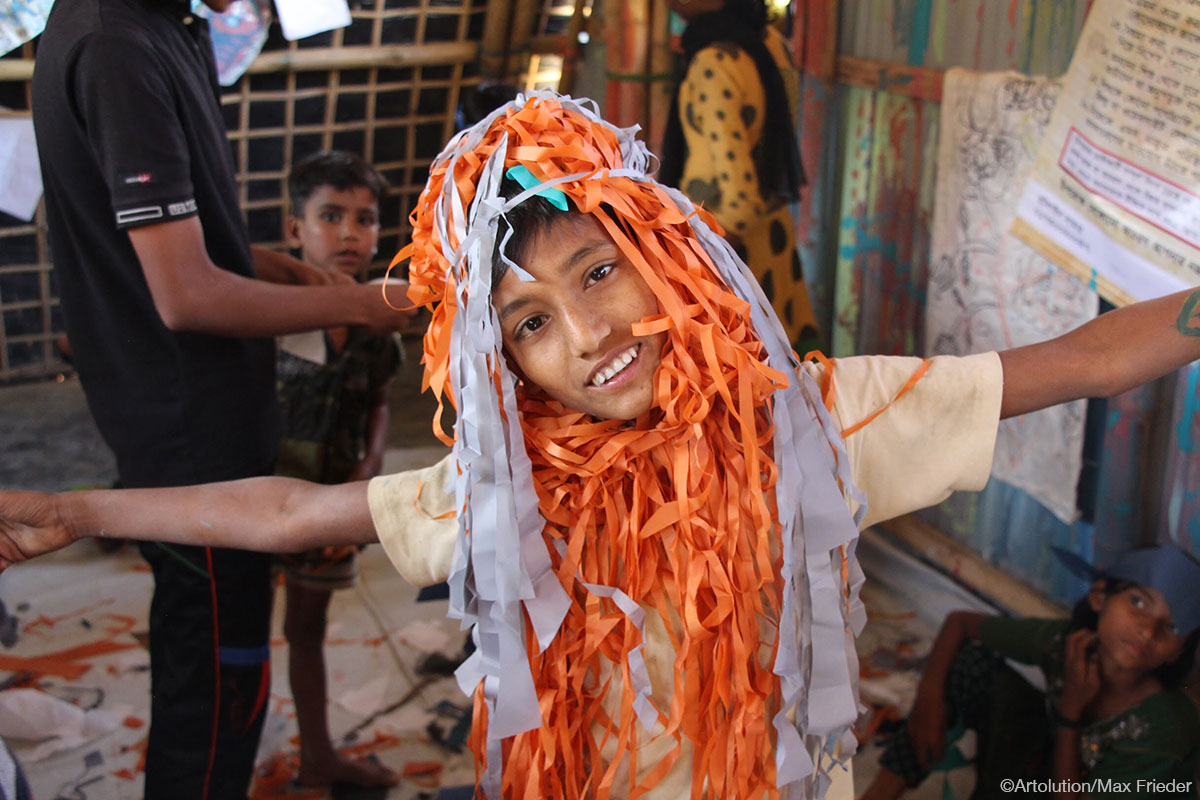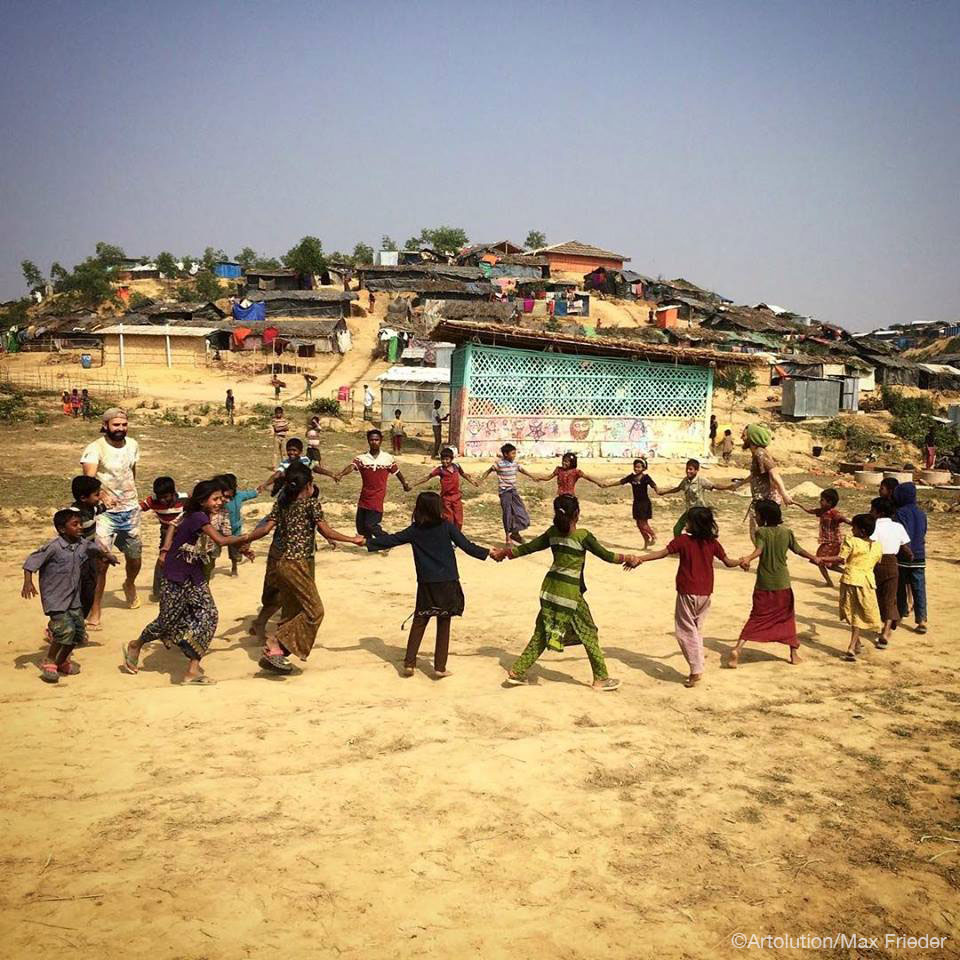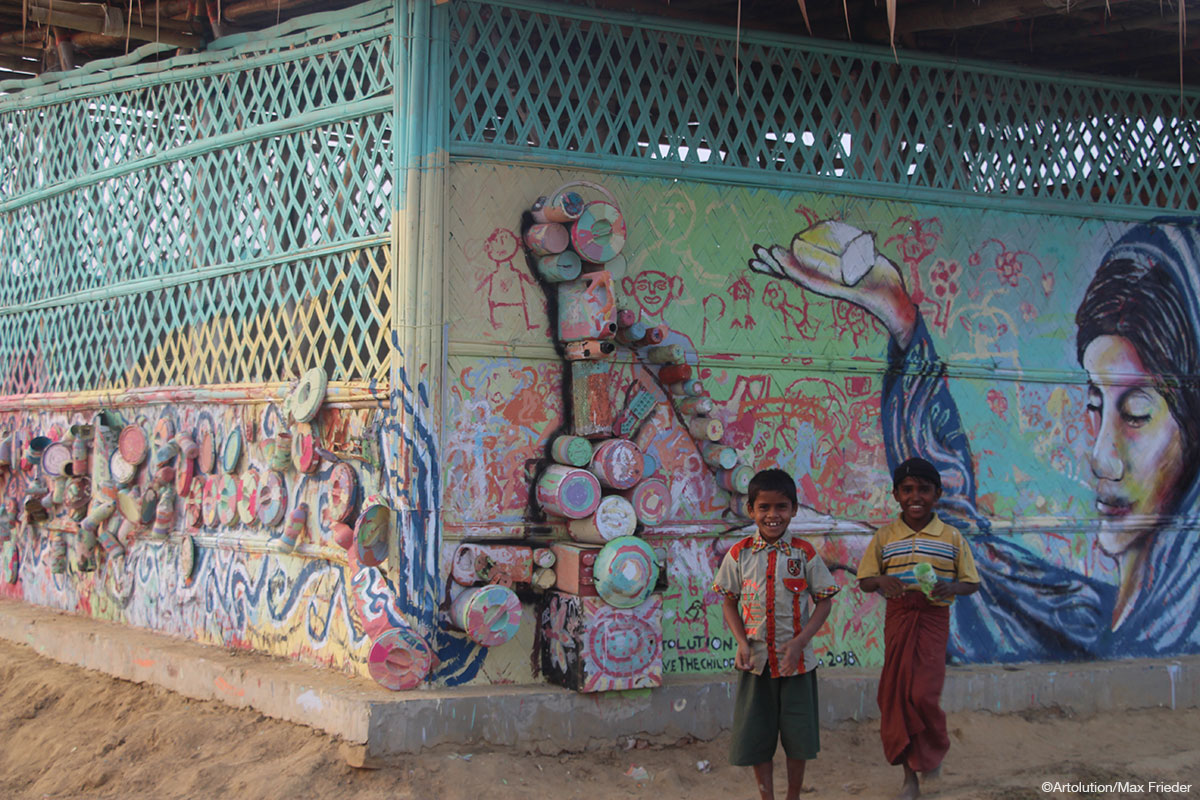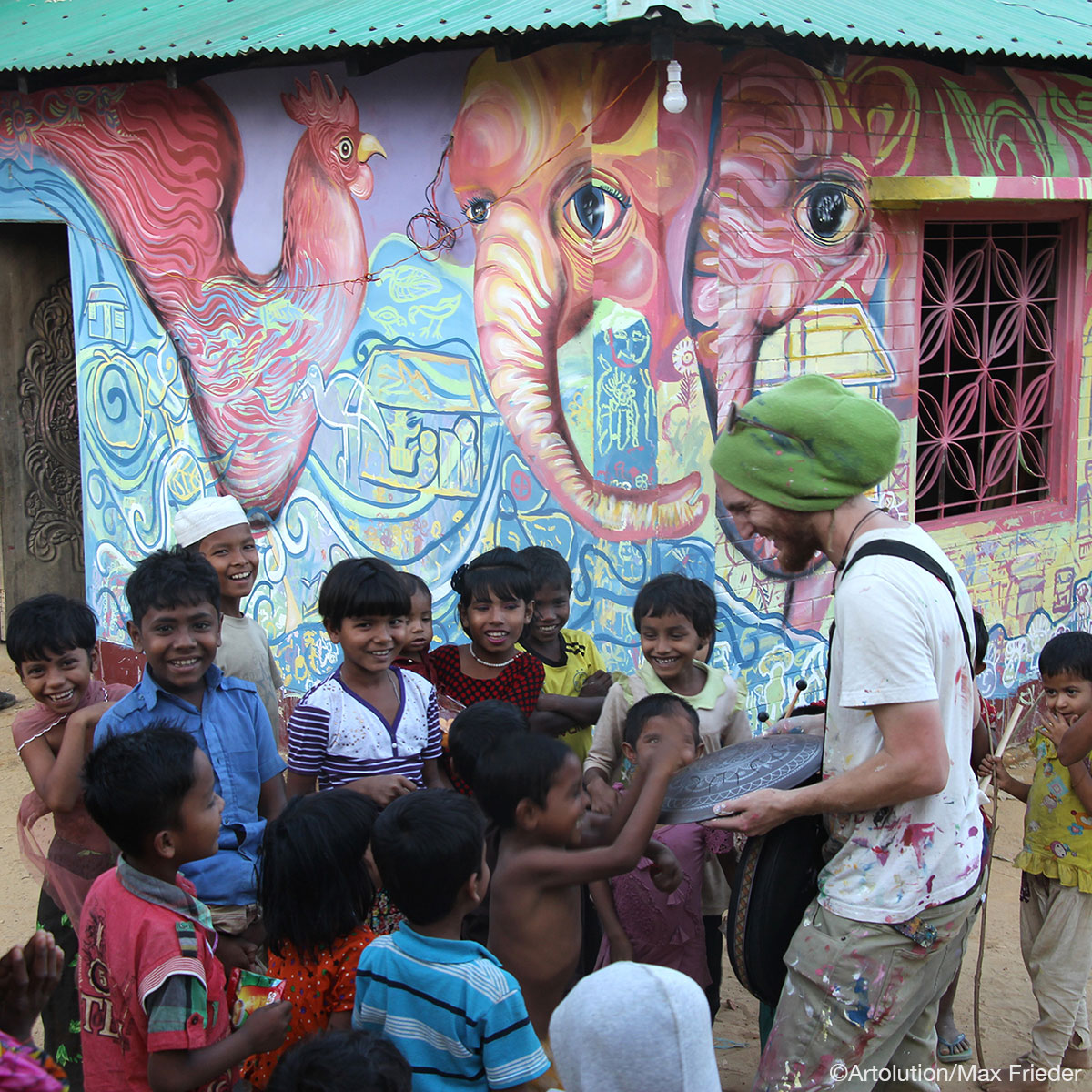Hello and welcome to MOAS…
Rohingya refugee children go through a lot.
They’ve escaped death, witnessed murder and crossed land and sea to find safety. Some have lost their parents in the chaos while others have become surrogate parents to their younger kin.
Up to sixty percent of the recent refugee arrivals to Bangladesh are children, many of them under eighteen years old.
Now in their relative safety they face new risks and dangers threatening their future.
Let’s speak to one of the projects trying to help them.
‘in addition to painting murals we did callisthenic activities jumping up and down on one foot and making different sounds woooooooooo, making different creature sounds and doing kinds of performance and doing different kinds of puppetry’
Artolution is a community focused project using art, expression and music with refugees as a therapy.
Max Frieder is its Co-founder and Co-Executive Director.
He spent five weeks in the Balukhali camp with local artists teaching the refugee children to express themselves and share their experiences and trauma.
‘So, I’ve worked in refugee communities for a long time and I’ve never seen anything like this in my entire life. There was just an unending spree of houses made of sheet plastic and bamboo on very muddy and dirt covered hills spreading as far as the eye can see. It’s a very difficult place with an unbelievably high level of child labour with very high levels of domestic violence. Additionally, there’s a very difficult feeling there of just the unbelievably large number of people.
One of the components that I really emotionally felt is just that you look at people and there’s just such a high level of trauma for every person. I think one of the biggest differences that I’ve substantively felt in this case is unlike in other cases with the Syrian civil war, it’s a horrific brutal civil war. The rohingya crisis is an ethnic cleansing, a genocide based on one specific ethnic group and the expulsion from their homes. So because of this there’s very different mental and psychological effects that come from an entire community being not just ostracised but murdered and killed and raped and destroyed.
I think that is something that I really felt that is number one; the unbelievably large amount of trauma that you can really feel in that community but simultaneously to also feel the unprecedented amount of thirst and hunger for creativity and expression. I felt that within the children and within the adolescents and within the families that I worked with where many of these people never had the opportunity to express themselves creatively. Being able to see them really work through some of their trauma and really establish different types of coping mechanisms through the process of creative expression on a public scale through painting murals and building public sculptures, it was something that was very powerful.’
What things struck you about the children you were working with in Balukhali?
‘I think one of the elements that really struck me within these children was, Number One; their lack of exposure to creative expression as a healthy mode of dealing with what they’d been through. I think these are some of the most beautiful and incredible children that I’ve ever really seen but in many ways just like children all over the world. But I think one of difficulties was that these children have no literacy neither in Burmese or in Bangla or in English so you’re dealing with an illiterate population that has been through very serious trauma and who really has a very unique way of processing what they’ve been through. You’re dealing on average with families between 8 to 16 children in a family. It’s extraordinarily common to be able to see children that would come and work in our workshop which is on average 20 – 30 children per workshop 2 – 3 slots per day.
However, because of the unprecedented number of people there we would have many times upwards of 100 to 150 children wanting to come and participate in the workshop. That was something that I think was very powerful. Being able to see how much these kinds of programmes mean to these children and coming and being greeted by this amazing excitement where I would come and the entire community would come out and we’d have 2 or 300 people all there just silently waiting for me and our team to do something and once it started it was just a huge flurry of energy.
One of the great stories that I have is that there was a real emphasis to try to have a very trans-disciplinary approach to being able to get the engagement of these children at a very high level. So in addition to painting murals, we did callisthenic activities jumping up and down on one foot and making different sounds woooooooooo, making different creature sounds and doing kinds of performance and doing different kinds of puppetry.
One of the elements of that was getting children to be able to make masks, being able to make different kinds of costumes out of trash and recycled fabrics which we’d actually collect from the side of the road, from some of the sweat shops in Bangladesh and Cox’s Bazar. We poured it out in the middle of the children friendly spaces we were working in and all of these children gather around and they look at this and they are all struck that they’ve never really seen anything quite like this.
They start grabbing this fabric and throwing it up in the air and start dancing and start singing and start really using this very simple medium into a mode of celebration and this started to really infect the community and I use infect in the best way possible. There are these very hardened men who walked over with these very stern faces and they looked at these children and I didn’t know how they were going to react, whether they were going to be angry or happy. Their response to this was to walk in and to start to grab this fabric and they started to throw it up to sing and to dance and to clap and to use it as this mode of celebration. The women of the community who rarely ever leave their huts were actually coming out and they started to celebrate.
It became this reason, this bonding of having a reason to celebrate, any reason to celebrate.’
Why community murals and how were they useful for the children?
‘One of the components I think of these murals is that they are not just murals but that they are part of what is called the ‘foundstrument – soundstrument’ project. It’s a project which I’ve developed over the last ten years working in 7 or 8 different countries doing this. What it is is having these children collect trash and unfortunately there is a lot of trash in these refugees camps in Balukhali.
Having the children being able to paint all of these different objects. Being able to use zipties and wire and screws and nuts and bolts and nails and make a sculpture which then is able to be used for music education on an ongoing basis. These children are then able to use the sculpture with the assistance of the artist that we’ve trained and with the local community facilitators, they are then able to use this to be able to express themselves in a healthy way. So rather than be feeling frustrated and hitting their brother or sister instead being able to take that aggression and let it out by using drumsticks out on this foundstrument-soundstrument. We have incorporated this into multiple of the murals we have created.
I think one of the other elements that is very important to understand is that these were the very first murals created in the history of the Rohingya refugee camps. The work that Artolution was doing with our local artists was the first public arts programme where public arts pieces were created by communities in the history of the Rohingya crisis. I think it’s very important for being able to create a model for what is possible and that is so important. It’s an example where you could tell the children and adults and sometimes even the teachers and the parents, ‘your children have talent, your children can make something beautiful’. They won’t believe you until they’re able to see it with their own eyes and be able to hear it with their own ears. Then they can believe, ‘Wow, our children had more talent than we ever thought they had’.
I think that’s a very important component when we start talking about murals is that one of the most powerful parts of this work is to watch the parents watch their children. I think it’s very important being able to have these adults seeing that their children maybe are able to accomplish things they never thought were possible and being able to have these local mentors and these local artists able to not only see what they able are to create but able to replicate it and scale it on an on-going basis. I think it’s something that is very unique about these murals and I think it’s also something that is very different to conventional art therapy.
Art therapy is very much rooted in this concept that you have a patient or a client and you have a clinician that treats this single client and rather than that this is something where you have children being able to be dealing with their common traumas while simultaneously being able to make an impact into their community on a public collaborative and cooperative scale which affects the lives of thousands of people on a daily basis and continues to, to this very day.’
What kinds of topics were you working on with the children to illustrate?
We really worked on a whole range of different issues which was really generated by the community. So rather than us coming in and telling them what they needed to learn it was hearing what are the biggest issues in their lives, both listening to the adults, the teenagers and the children and then being able to generate a curriculum accordingly. We have a standardized curriculum that we work with but it adapts according to what the needs are of the different locations where we were working.
For example, one of the projects that we did, we were asking what are the most important issues and one of the children said ‘Water, we need to talk about water, it’s so important’ and another little girl raised her hand and said ‘we should draw a woman at a water pump because that’s how we can get clean water’. And another child said ‘what if we have soap in one hand and that represents the importance of us cleaning ourselves’ and then another child said ‘what if coming out of the faucet, we have dancing children who are all dancing about the importance of cleanliness with soap in their hands’. These amazingly lyrical and poetic concepts really communicate much deeper messages where we ended up painting a woman with a water pump. Then one of the children said, ‘what if we made the foundstrument out of the water pump?’ and we were able to attach all of the different trash and recycled objects into that mural.
Then if we take another example of a mural if you’ll believe it. There’s this very interesting socio-cultural scenario that has really evolved in this camp that really has almost never evolved ever before. Because of the unbelievably rapid expansion of the Balukhali camp, you had local Bengali people who are living in that community, who are living in that very remote area who because of how rapidly the refugee camp expanded, their homes got swallowed up by the refugee camp so you actually had host communities that are inside the refugee camp.
Its a very difficult thing to fathom so because of that you actually have a lot of people who are living right alongside. There are some beautiful stories of some amazing helping hands and co-existence and yet there’s also some very difficult stories about ethnic tensions which have arisen between the local Bengali communities and the Rohingya. So, because of that, we did a project with a local host community of local Bengalis and the local Rohingya working together. What they decided to show was very amazing poetic story where the children came up with this concept of saying, ‘what if we represent our families?’. This actually came from a much more difficult and much deeper conversation where I asked the children to make drawings and the one of the girls made a drawing of all their homes being burned and all the people being killed.
That actually wasn’t just one girl but many of the children making these drawings of their families all walking and running on paths and across the river. When I asked the girls, ‘tell me about what you painted’, they said, ‘we feel that we would really love to go back to Myanmar but the only way we will go back is if our rival factions were killed’. This kind of education where it’s something that I think is model behaviour can really create a difficult situation where it’s very hard to fathom what does it mean to return, what does it mean to be stuck in this refugee camp and what does it mean to try to think about what past conflicts mean for the future of these children’s lives.
So, when we ended up having a much deeper conversation with these children, we said, ‘OK, how can we show this in a mural?’. There was this amazing story where these girls came up with a mural, these girls came up with a concept of saying ‘we really believe strongly that we need to show our families crossing over the Naf River’. So, they decided to show themselves as elephants, ‘what if we show ourselves as elephants where they’re carrying their homes on their backs, the homes that we used to live in on our backs. They’ll be crossing the Naf River to be greeted by the rooster’. The rooster represented the hospitality of the Bangladeshi community, and that’s what we ended up painting.
So this idea of local host communities relationships with the local refugee Rohingya population.
Artolution is just one of many aimed at helping the new generation of Rohingya.
They face considerable risks and dangers as vulnerable refugees.
The rainy season is coming and with it, disease and rising malnutrition.
But, the children are resilient and they can see their environment.
They want to change it and for Max. it starts with a paintbrush.
If you liked this Podcast don’t forget to hit like, comment and subscribe for more Podcasts from us.
You can also follow us on our social media. Check out our latest updates on Facebook, Twitter, Instagram, Youtube and AudioBoom… or you can donate to help us help Rohingya refugees.
From all of us here at MOAS: goodbye.

